Archive for the ‘digital publishing’ Category
Northeast Exhibitions Editor for caa.reviews
Over the past year, I have been working as the Northeast Exhibitions Editor for caa.reviews and thus far it’s been a great experience! Fortunately, my job is relatively easy or perhaps better stated fun. I search out exhibitions that deserve to be reviewed throughout the Northeast (but not including NYC). As I find, important exhibitions, I then need to identify potential reviewers. I had heard that commissioning non-paid reviews from people was difficult, but thus far, I’ve been able to quickly find writers or have people even volunteer reviews for exhibitions that they felt passionate about.
Once the writer and I agree on a deadline, we bounce the review back to one another to arrive at the final product. It has been a great learning experience to envision exhibitions that I have not visited myself through the writing of the reviewer. And as editor to work with the reviewer to create a clear sense of the exhibition and its power for readers who may as well not have the opportunity to see the exhibition first hand.
Thus far, I have had the pleasure to work with the following writers:
Valeria Federici on “Art in the Age of the Internet, 1989 to Today” at the ICA Boston.
Christopher Kasprzak who reviewed “Calder: Hypermobility,” at the Whitney Museum of American Art.
Ellen Handy who wrote an excellent review on “Clarence H. White and His World: The Art and Craft of Photography, 1895–1925” at Princeton University Art Museum.
John Muse on “Yoonmi Nam: Still” at Philadelphia’s Print Center.
There is more coming soon!
How To Get The Best Screen Printing Results From Your Art Submissions
Custom t-shirts are more than just an excellent way to express yourself, they’re also incredible ways to get your artwork in the public space. Whichever you’re placing a custom order for, it’s important that your art or design comes out the way you want it to.

There’s nothing worse than seeing your work of art fail to translate to what you had in mind, which is where following this guide can help. Here’s how to get the best screen printing results from your art submission on sites like The TeeHive or Threadbird.
Using Vector
Vector based images and screen printing are a match made in t-shirt heaven. These files can be resized at any scale without losing an ounce of detail thanks to the mathematical equations surrounding their magnitude and direction. Even better, these images use both lines and curves.
When it comes to color assignment, vector is superbly clean. All you’ll need to create a vector image is a program like Corel Draw, Adobe Illustrator, or Inkscape.
Using Raster
Unlike vector images, raster uses pixels instead of lines. This makes using the correct DPI crucial from the get go, but it translates wonderfully to screen printing when done correctly. For reference, a web image looks stellar at 72 DPI while screen printing requires at least 300 to look decent.
While you might not be able to scale up with a raster image, you can create images at the same size they would be on the t-shirt. This gives you the ability to pay close attention to small details, which also helps in translation. Programs like Photoshop and Gimp utilize these types of images.

Screen Printing 101
The true secret to achieving a fine quality print is using highly defined artwork. That can be easier said than done, as many people find themselves with excellent art that simply isn’t ideal for screen printing.
Often times, individuals opt to do a test print first to make sure their design will translate like they want it to. While it’s always a good idea to test out a company’s quality first, test prints are often made using a different technique. Most of the time, companies will use a digital print or direct to garment printing.
The best way to make sure your art will look fantastic after the printing process is done is to contact the company you plan to work with. It isn’t uncommon for their artists to be able to recreate your image in a more screen print-friendly version. Always double-check to see if that comes with an extra cost, though.
Tips and Tricks
When uploading files to print, make sure they were created in the proper format beforehand. Simple saving something as a .pdf or .eps isn’t going to cut it when it comes to the quality you’re looking for.
Avoid using:
- .jpg
- .png
- Photographs
- Sketches
- Or anything with a low resolution
If you are dealing with hard copies of your artwork, it’s best to email the company you’re considering working with. Most have designers on hand that can work with you to ensure your work of art translates properly to the screen printing process. If you happen to live close by, it never hurts to drop in for an in-person chat.
Getting the Color Right
If your design is pre-made and ready to go, then all you’ll need to do is pick the color garment you think it would look best on. Try out different option to see what you like the most, and don’t be afraid to use multiple colored clothing items.
When designing from scratch, you have more ground work to do but a lot more room to play with. Simulate both ink and garment color combination by creating mock-ups first so your can proof the results before placing an order.

Most printing services use Pantone colors, but it’s important to keep in mind that the colors you’ve used in your vector or raster piece might become slightly off during the printing process. This happens because computer monitors vary widely in color, brightness and contrast.
What you see on your monitor might not be the same the printer sees on their screen. If you own a Pantone Solid Coated Formula Guide, then making a note of which shade you intended to use will solve this problem. If not, the printer will choose the closest available Pantone based on what they see.
Nailing the Best Prints
Getting the best screen print results for your artwork takes some time and dedication, but the above advice will help your work translate the best it possibly can. You’ll have a slew of awesome t-shirts ready to go before you know it!
This articles has been written by Ashley Lipman
Trump Administration Fantasy League



I don’t play fantasy sports, not because I wouldn’t enjoy it, but more so because I’m not enough of a sports fan. I am however a measured political junky, so when I learned about the Trump Administration Fantasy League, I discovered a fantasy sport that I could find the time and interest to join! Join the Trump Administration Fantasy League by using the site’s random number generator to draft seven unique players from Trump’s administration that includes a selection of 29 players. Then track the league news via Twitter and see your players gain points! The creator of the site Matt McCaleb has been closely monitoring the latest news on the Trump administration to maintain up to date player stats!
Currently former National Security Advisor Mike Flynn is at the top of the score board at 100 points. Devin Nunes is a far second at 65 points. Trump needs to up his game as he’s only fourth at 35 points. If he launches a war against North Korea, I’m certain he’d win hands down (although I don’t see launching a war as a possible stat). The stats used to measure the value of the players include:
- Arrested / Arrests another player 100
- Dies / Kills another player 100
- Resigns / Is fired 75
- Flees jurisdiction 75
- Turns state evidence 75
- Prosecuted for a crime / Prosecutes another player for a crime 75
There are many more stats and some that I question the low value of such as “Fabricates information/Reveals another player’s fabrication of information” as only 10 points. The fabrication of information can of course lead to overwhelming consequences, so I feel it should be worth more. Or perhaps in the new world order, information fabrication is far too normalized to be worth much…
It’s tough to select a team, do you go for the most outspoken that may be out of the game sooner than later such as Bannon or the sleazier ones that may play the long game such as Devin Nunes? And why are Eric and Donald Jr Trump one figure?
With the current 29 players, I would select the following seven:
- Steve Bannon
- Kellyanne Conway
- Devin Nunes
- Jared Kushner
- Rex Tillerson
- Vladimir Putin
- and Donald Trump himself
Hong Kong Glitch
I don’t recall what compelled me to start saving images from the Hong Kong protests last year. However, as I saved them, I began manipulating the digital files by changing the files extension to be able to open them in a basic editor as text and to read the meta data on the images. As I did so, I would rearrange the data making up the image itself. It seemed appropriate to confuse the file by cutting data, changing the order of the data or adding new data. Not unlike the Occupy Movement here in the United States, the Umbrella Revolution appeared as a young and inspired population that would eventually dissipate against an all powerful ruling force. Perhaps, when this generation comes to power, they will recall the energy and desire of this time. I’ve decided to arrange the images into a small book that is available on Blurb or you can merely view the images online. Below are a few images from the series of 20.

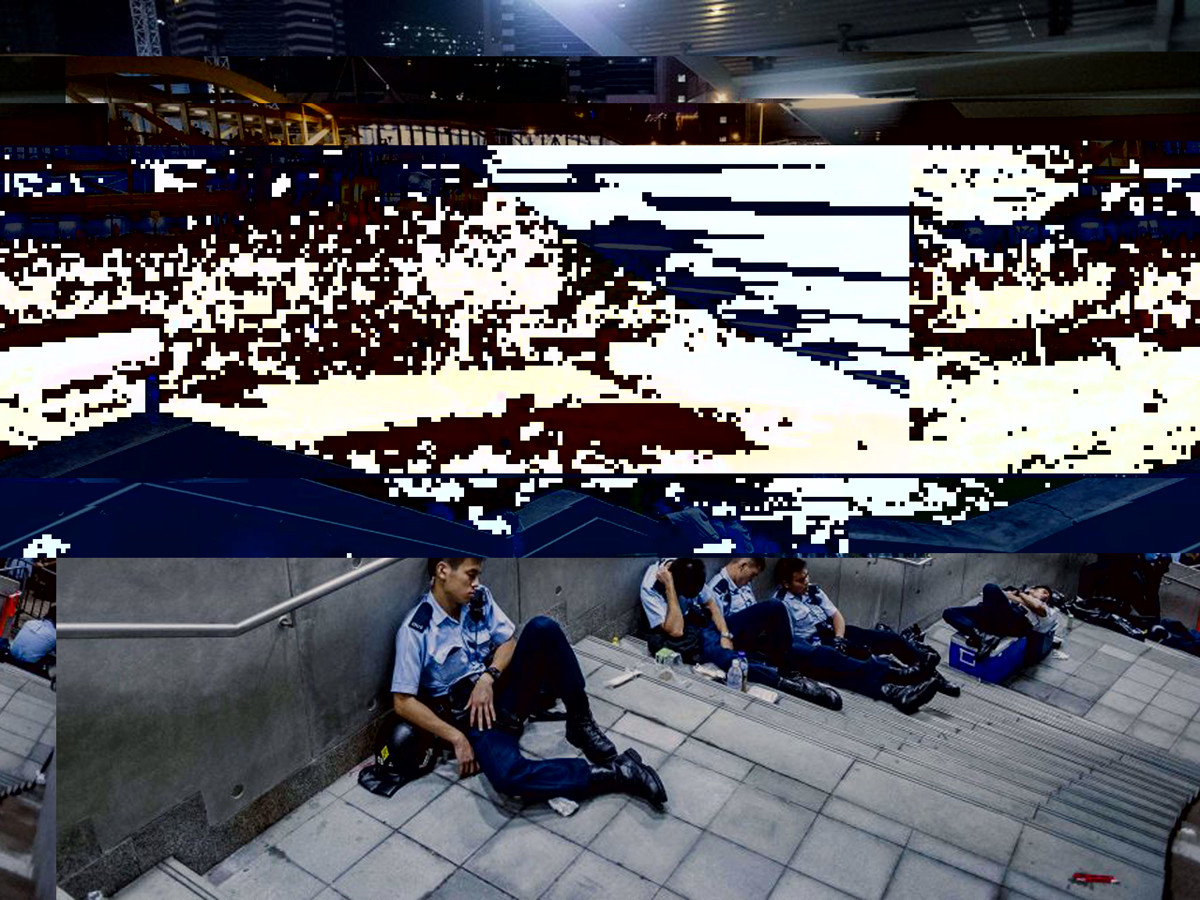


Digital Publishing Innovation Summit, Part 6
Following lunch on the second day of the Digital Publishing Innovation Summit, Jason Wagenheim of Teen Vogue took the stage to discuss what Teen Vogue’s mobile strategy to increase audience and traffic. As Kremins of Epicurious pointed out, mobile ad engagement is key while the reader is in store, when it matters most. It is at the moment of shopping while in the store that Teen Vogue can help retail advertisers connect with its audience.
Wagenheim pointed out that 17 year olds have smart phones and she influences the rest of the family, the 17 year old with the smart phone is powerful force that advertisers must successfully target. He stated that by 2018, internet traffic will be 35% mobile and 65% desktop. Social networks function as a mobile gateway, referrals are 25% social, 33% search based and 39% direct.
Although native apps present the advantage of third party APIs, Teen Vogue decided to focus and optimize for mobile web. Since doing so there was a 33% lift in unique visits largely due to batching image resize for mobile web. By 2018, less than .01% of consumer apps will be financially successful.
Wagenheim presented a case study in which a mobile product launched in unison with a sales event. The launch was designed to showcase partner content and drive retail engagement. Targeted coupons were presented via the mobile web app at the moment of sale. The teen would take a picture of the dress and share it along with the coupon id and sales skyrocketed. Wagenheim did make a point that business partners must use their own mobile tools for an ad campaign to succeed for everyone.
Teen Vogue partnered with a couple of developers from Taiwan to create “me girl” that lead to 4 million installs. Users use “me girl” to dress an avatar, see what an outfit looks like and then purchase.
Wagenheim ended his presentation by stating the following keys to success:
- Know your audience’s consumption trends, most visible via mobile web
- Support intuitive behavior through UX development
- Understand internal resources and limitations
- Execute a social conversion strategy
- Plan for change

Teen Vogue’s keys to success for mobile advertising
Following Wagenheim, Hayley Romer of The Atlantic took the stage to discuss “The Role of Premium Publishers Today.” She stated that publishers need radical change without changing who they are. And went on to discuss the paradoxes of programmatic advertising such as:
- sell on quantity versus sell on quality
- advertisers want CPM data but are unwilling pay for it
- shorter is better versus longer is better
- mobile is our downfall versus mobile is our future
Regarding “shorter vs longer” she pointed to the two top stories from 2013 and 2014. In 2013, it was a data visualization simulating “World Births and Deaths in Real-Time.” Whereas in 2014 it has been Ta-Nehisi Coates’s “The Case for Reparations,” a 16,000 word article. This demonstrates that it’s not about shorter or longer being better, but rather presenting compelling content in the right format.
Regarding “mobile downfall vs mobile future,” Romer pointed out that mobile usage is up 43% whereas ad spending breaks down to 7 cents on mobile, 14 cents desktop and 83 cents for print. 2014 banner ad spending is at $10.27 billion and expected to rise to 11.29 billion by 2016. Romer’s keys to success are:
- Strong Concept
- Brainstorm different ways of telling the story based on the medium… what is the right format
- Testing
She presented the highly successful visualization of red lining in Chicago, because it doesn’t present the data in words, but rather a time-based visualization onto a map of Chicago to visually show the information.
Amongst the weakest speaker at the summit was Mike Germano who presented a Vice commercial, talked about being a Yankees fan and then went on to give a motivational pitch on the importance of fear. He was very charismatic, but really did not present anything of value. And I missed the final speaker Paul Rogers of Liverpool FC who discussed the need of thinking global while acting local as a form of media engagement.
Digital Publishing Innovation Summit, Part 5

“Contextual shopping is coming…” Epicurious has partnered with Target to use iBeacon for in-store advertisement and coupon deployment
Carolyn Kremins of Epicurious was the fifth speaker on day two. She began by presenting data on the rise of mobile, however advertisers have not figured out how to reach mobile users. The same banner ads that work on the desktop are employed on mobile, however they do not work on the mobile platform. Generally, when people click them, it’s by accident. She did point out that native apps can be highly successful as the Epicurious App demonstrates – #1 in food and lifestyle, 450k sign ups for recipe box in first six weeks and people spend 28 minutes per user over the last month. Due to the nature of mobile, Kremins feels that the future of mobile advertisement is in in-store engagement. Apps that present content – information and coupons when the shopper is walking through a store.
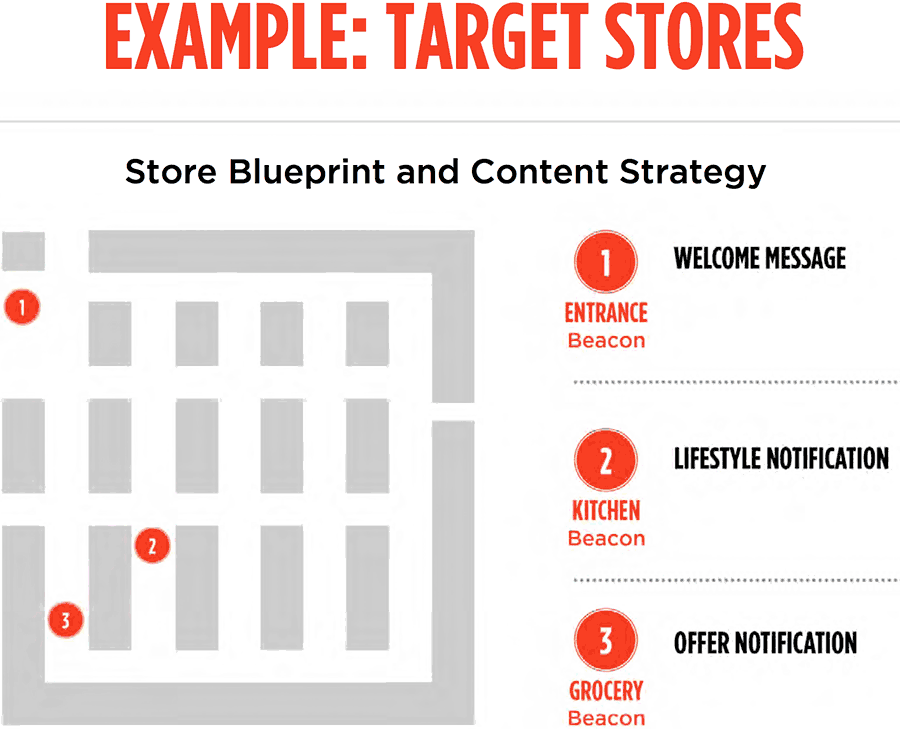
In-store advertisement deployment via app on smart phone
Kremins went on to discuss mobile geo-targeting via iBeacon as the future of shopping. Epicurious has partnered with Target to launch this emerging form of advertising. iBeacon uses blue tooth to connect with the phone app. The iBeacons will be strategically placed throughout the store to present a series of messages from a Welcome message upon entering, a lifestyle message and then an offer notification. Studies show that 2/3 of consumers are okay with marketers using online behavior and information to personalize ads. Hence a personalized shopping experience is likely to be a boon. Rather than receiving unwanted ads randomly upon opening an app, the app will launch at the appropriate time to present useful deals at the moment of shopping. Kremins stated that “contextual shopping is coming. Users are 19x more likely to engage an ad and 16.5x to use an Ad in store and a satisfied user is 6.5x likely to keep the app. The key to Ads is to present a value to users and create transparency of opting-in. The value of the perpetually connected shopper can not be underestimated.
Laura Kenney of YouBeauty.com followed Kremins. The primary point of Kenney’s presentation “What a Difference Your Data Can Make” is the effective use of quizzes to gather data on their users and spin the data into personalized content. She used the term “Information Diet” coined by Clay Johnson in referring to the YouBeauty.com website as the plate, and the content the nourishment. Users engage with the personalized and favorite content first followed by the desert content. Kenney feels that appropriate uses of quizzes can make websites into data machines. Quizzes may be used to connect users with brands while presenting personalized valuable information to the user.
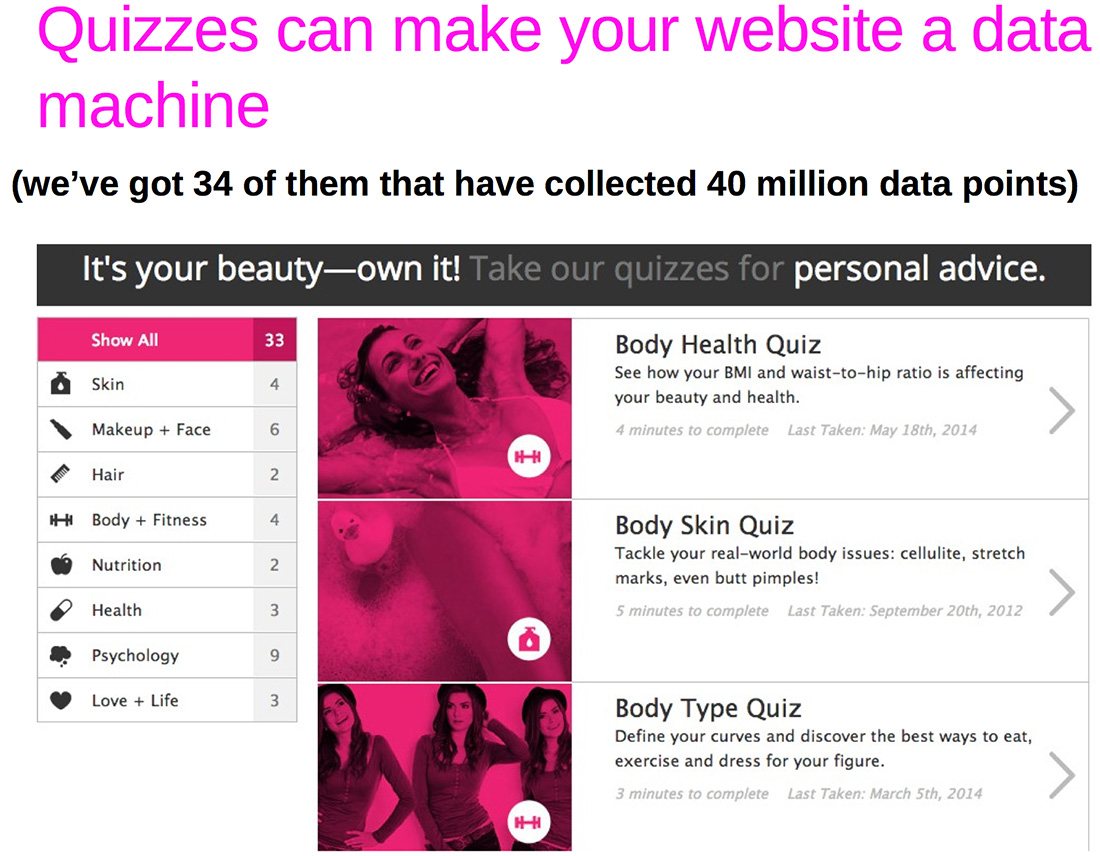
YouBeauty.com employs quizzes to present personalized content to its users and to connect users with appropriate brands.
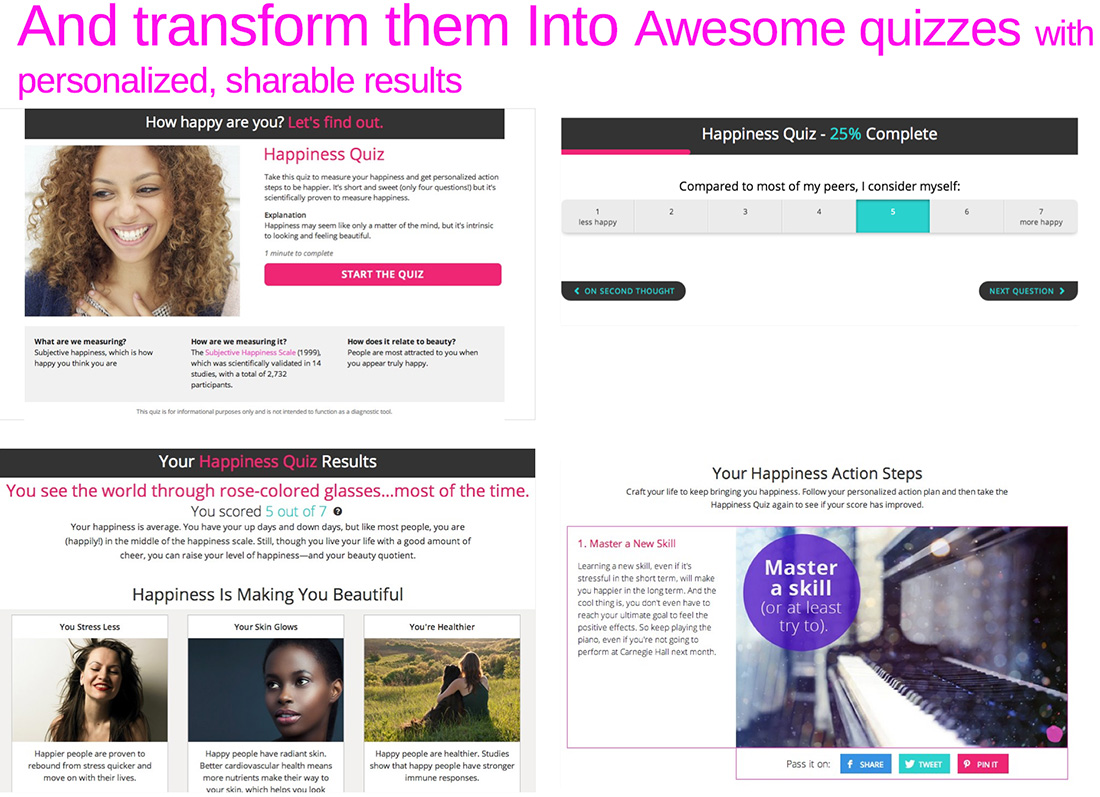
YouBeauty.com makes quiz taking fun and presents the data collected in a useable format.
YouBeauty.com knows that their readers are obsessed with body shape, personality, attachment style, lipstick and healthy hair. This insight is a tool to organize and present a successful website. A key to YouBeauty.com’s quizzes has been making quizzes fun to take and useful for the reader to see the quizzes output. Of course as with all these brands, YouBeauty.com has uses with social applications and referred to Pinterest as a “slow burn” whereas FB is a quick spike.
Kenney did warn of too much information and the need to use refined data metrics to understand what information is useful and what works on the site and to get rid of what is not working.
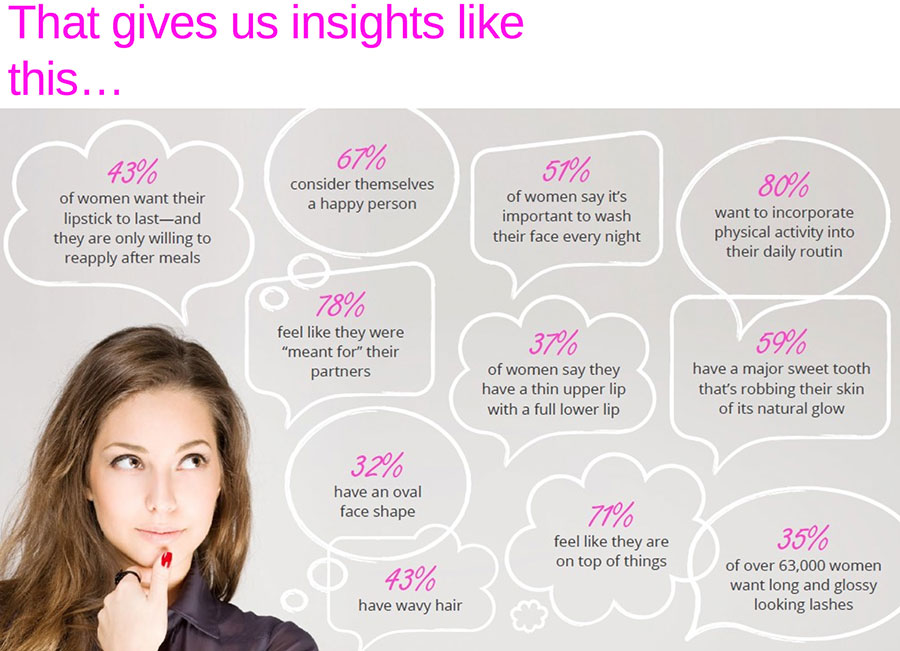
Through the quizzes, YouBeauty.com knows its users.
Following YouBeauty.com founder was Tim Clark, senior director of digital media for NASCAR. Clark began by describing failure and the understanding that people do not like change regarding their interfaces. What has worked for NASCAR is “competition based storytelling…” people like to consume drama. The effective formula for NASCAR is:
Quality Consumption = (60% Scroll Page Views + Video Completes) / Visits
This is not merely landing on a page or clicking on a video and viewing the beginning, but actually tracking the depth of consumption for pages as well as videos. Clark identified the peak hours for user spikes as 8am, noon and 6:30pm.
Following NASCAR was Angela Tribelli of Harper Collins. She discussed the transformation of Harper Collins from being “disinter mediated” between themselves and the reader to becoming a platform that connects their authors with the consumers. She broke down 5 myths about book publishing and the ones that I found most interesting are the last three: 1. “Media consumers have short attention span,” 2. “Only fresh content sells – consumers always want what’s next,” 3. “Self publishing will put an end to traditional publishing.” And in response to these myths, Tribelli presented these realities:
- Amongst the top sellers for Harper Collins last year were Veronica Roth’s Divergent series. Each book is approximately 500 pages. Consumers desire immersive reading.
- Regarding “only fresh content” there is an enduring backlist of opportunities, because the classics sell. Amongst the lasting top sellers are The Alchemist, 1988, Brave New World, 1932, To Kill a Mockingbird, 1960, Their Eyes Were Watching God, 1937.
- And regarding the last myth, although self-publishing presents a great opportunity to new writers, Harper Collins value proposition can not be matched, as demonstrated in the image below.
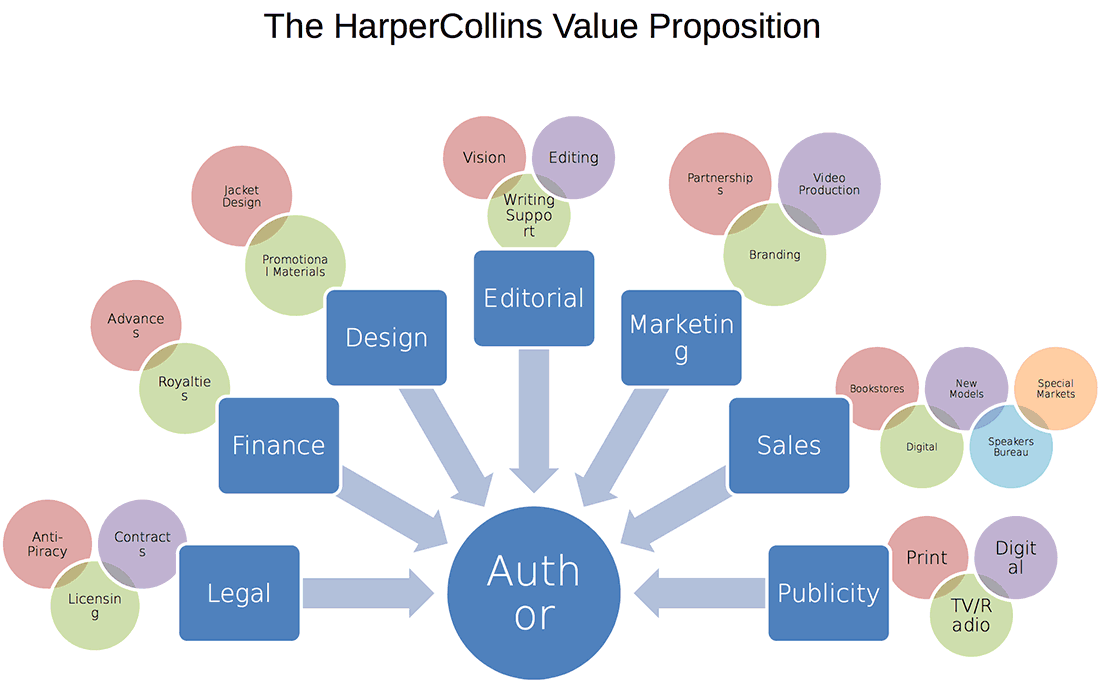
Self publishing can not match HarperCollins value to its writers.
Tribelli sited finding the right audience as the biggest challenge for publishers today, because publishers have traditionally been “disinter mediated.”
Digital Publishing Innovation Summit, Part 4

Emerging trends, behavior and takeaways for social media use
On day two of the Digital Publishing Innovation Summit, I missed the initial session “Data & Technology Influencing Corporate Culture” by Charlie Weiss. So I started off the day listening to the very entertaining Cindy Jeffers from Salon presentation “Reaching the Next Generation of Content Consumers.” Jeffers stated that younger people are moving to anonymous and ephemeral sharing platforms rather than using FaceBook or Twitter. She discussed the rising use of Whisper and Secret – social networks that disassociate from public identity in which messages tend to be raw, present catharsis and negative emotions. She also noted that news tips and corporate leaks are common on these anonymous sharing applications. Since anonymous sharing presents a rapidly growing sector because one isn’t tied to her/his identity, it requires greater vetting.
Amongst 18 to 22 year olds, expiring or ephemeral content through Slingshot or Snapshot is becoming very popular. Users can have fun sharing funny things and selfies without worrying about future consequences. These applications are even built to not allow screen capture to ensure the ephemerality of the content. Research shows that the vast majority of content is light-hearted and a superfluous way to connect with friends. Although sexting has been in the media, users that were polled showed very little sexting. These tools represent an outlet without lasting consequences due to archived content.

Apps that Are Gaining Steam
So the summit specific question is how can brands use these anonymous and ephemeral sharing applications? Jeffers believes that companies are already using these social tools for research. Brands can use these applications to ask questions that generate discussion and gather feedback on products, advertising, branding…
Laura Wind of Macmillan Education followed Jeffers with a presentation titled “The Future of Educational Publishing.” I’ll quote Wind’s description of her presentation to set her premise:
Higher Education in the US is in dire trouble. Between degree mills, low retention rates, and unemployment rates for degree holders, there is an obvious disconnect between the amount of money we spend in higher education and the return on the investment. Yet, the high price tag of education clearly doesn’t paint the full picture. Despite a surge in MOOCs a couple of years ago, their development and usage is currently at a rapid decline. To boot, while ebooks are beginning to surpass print books in trade, that same trend has still not transitioned to the classroom. This is largely because the education system has not kept up with technology and buzzwords such as “flipping the classroom” are often used in place of action. How do we bring about more rapid change so that the education system keeps up with the rapidly changing world? Where will educational publishing in the next, 5, 10, and 20 years? What role do publishers play in improving the higher education system and ensuring the success of our students and, thus, our future?
Wind went on to point out the enduring power of a college degree – it puts the stamp of approval from recognized universities on the successful student. The degree demonstrates that the individual is employable. Massive Open Online Courses (MOOCs) do not do this and the target audience – those who do not have access to education are not the primary users. 80% of MOOC users already have degrees, so the common use appears to be people seeking to expand their knowledge (however, the vast majority register and do not return).
Wind stresses the need for schools to act on the phrase “flipping the classroom” and not merely use it as a buzz term. She feels that the future of higher education is not the tradition of in-class lecture and then the student goes home to do homework. Instead, the lectures are watched at home and the projects are executed in the classroom with the professor there to direct and assist. Passive learning does not translate to the workforce. However, actually “flipping the classroom raises the bar on teaching, because there are likely to be unexpected questions, moments that when the faculty’s knowledge is tested, because the classroom experience will not merely be a prepared lecture.
Wind briefly discussed the ramification of education through the use of badges and analytics. Analytics may be used to make adjustments during the semester. Analytics should also be used after the student graduates to track where they are going.
Jorge Urrutia of Fusion stressed the need for greater research on Millennials to understand more deeply a gigantic consumer base. Millennials or Gen Y born in the 1980s and 90s will be over 50% of the labor force by 1916. Over 5000 brand messages pass by Millennials on a daily basis and yet they are hard to reach. This is because Millennials are misunderstood. Urrutia broke down common myths about Millennials:
- They are homogenous
- They have different values
- They don’t care about career and workplace
- They are narcissistic and therefore the “Me Generation”
One example regarding the homogeneity myth is the popular show “Girls” in which the main characters are all white, don’t receive help from their parents and are not worried about money. One third of Millennials get money from their parents.
Urrutia pointed out that grouped into Millennials are people in different life stages. Younger Millennials between 18-24 that have an 11% unemployment and an average salary of 30K, and older Millennials between 24-35 who have families and spending power. Fusion maintains a 500 person panel of Millennials to query. Through this panel, they have found that Millennials social priorities are education, poverty and public safety and their concerns are the environment, mental health and LGBT rights. Whereas older adults social priorities are education, poverty and physical health and concerns are veterans/military, the environment and public safety. He pointed out that regarding mental health, Millennials are a high stress generation that have grown up on opioids and stimulants.
Another factoid that Urrutia shared is that the average mid-20s employee stays at a job 16 months. These are young adults searching for a passion and who desire collaboration and team work. What the media has popularly labeled the “Me Generation,” Fusion call the “We Generation.” 47% of Millennials in the U.S. donated to a cause in the past month. 87% donated to a non-profit over the past year.
Urrutia confirmed Jeffers belief that brands are already using anonymous sharing apps. Fusion uses Whisper to get data at a granual level. Recently they wanted samples from college students on what drugs they use, what celebrities they follow. Data was gathered from colleges based on zip code.
Urrutia wrapped up with an example of Millennial media intake through the success of a microsite revolving around people at the World Cup. Every evening a different topic was investigated through streaming video from a World Cup location in Brazil.
Digital Publishing Innovation Summit, Part 3

Very specific content can reach a giant audience through the emotional connections of sharing.
Following Jacobson of The Blaze (see second post of this series), Nick Rockwell of Conde Nast presented “How Much does the Product Matter?” Without a doubt, great content is the key. This was a driving point amongst many of the presenters – that quality content will eventually pay off in sustaining readership and engagement. Of course as this is a digital innovation summit, the questions at hand are how to cultivate engagement on the web and across platforms. Rockwell presented a slide demonstrating how much effort goes into UX development. Conde Nast has 70-80 people working on user experience and amongst all the companies at the summit, some 750 to a 1000 UX developers which adds up to an estimated budget of $120 million. Add another big publisher and it’s easily $500 million a year going into user experience. However, a full-site redesign only generates a 7% lift in key performance indicators after 12 months. A 3 month recirculation optimization boosts session depth by 3.5% at best. Rockwell’s point was that all the UX investment isn’t paying off and more money should go into Ad design.
He demonstrated how little ads have changed over the last 120 years by showing a banner add from the 1990s that looks like current day banner ads and then a newspaper ad from 120 years ago that was likely more effective. Considering ad space – television ads have 100% of the screen space, print magazines – 33-50% whereas web 5%. There is currently a lot of ad innovation happening through targeting, following clicks, but there needs to be more innovation in presentation. It’s difficult for me to gauge his arguments as I have Ad blocker on my browsers. I’ve discovered that friends without ad blocker have a very different web experience than my own. However, there has been innovation in content distribution that requires the viewing of ads. Due to my ad blocker, last NFL season, around mid-season I was shocked during my Monday morning ritual of seeing highlights when the videos would not load unless I turned off my ad blocker. And of course, Hulu has attempted to re-established the television scenario, but with multiple tabs open, I just switch to browsing or reading while the ads play out. I imagine that before long, the ads will pause whenever I switch tabs.
Stephen Loguidice of BuzzFeed discussed the historical transformations of content distribution. He started off with a great visualization of the growth of the U.S. railroad system followed by pointing out the transformative power of the addition of photography in print, then the rise of television and the recent move to streaming content. Today, it’s all about the social. The new form of distribution is social feeds. The content that is shared and distributed via social feeds reaches the largest audience. BuzzFeed, of course, is all about how to create something for the way that people are consuming content. He pointed out that there are two underlying goals between sharing:
- We share to form community, because people are inherently social beings.
- We share to build personal brand.
For companies and brands the questions of distribution needs to be changed from “What do they want?” to “What do we want?” There is no they, it is all of us, we are all consuming and sharing… we are the distributors. The distributors are no longer some other entity or ad company. So we can ask ourselves, what is it that we like to share? Loguidice makes a pitch for the following emotions / sensibility for sharing:
- Inspiration, we like sharing inspirational, uplifting stories, one example is the batman kid in San Francisco.
- Identity… things that we identify with and make up part of our identity that may be about sexuality, cultural background, food, sports, location…
- Humor – it’s inherently social. If one laughs or is sufficiently amused, it will be shared.
- Nostalgia – memories are social and present a snapshot of oneself and likely others.
- Capture the moment – related to memories and archiving / snapshot that is meant to be shared.
Loguidice discussed the science to social… studying the real-time analytics to understand how content is shared. For example, a tweet will have the life span of an hour or two, whereas FB a couple weeks, Pinterest a few to several weeks.
Following Loguidice, Tessa Gould the director of native advertising at The Huffington Post discussed the creating of successful native ads. Perhaps the underlying term is Authentic Advertising and the formula consists of appropriate advertising for your content that is informative and or entertaining. If it’s the wrong ad on the wrong platform for the wrong audience it is not only destined to fail, but could lead to a lash back by the readership.
Gould presented The Atlantic’s sponsored ad for the Church of Scientology as a recent example of a poor match. The aftermath for running this ad was so bad that it was not enough to take down the ad, but The Atlantic had to write a letter of apology. (Even today, if you Google “The Atlantic Ad” it’s the first thing that comes up.) Gould summed up by stating that this was an ad that did not bring any value to it’s reader, either as information or entertainment, I’d say that it did worse than not bring any value as it caused so much outrage. So, authentic advertising is appropriate for the platform, reader and brand.
A successful native ad is the collaboration between Trulia and Barbie. The Trulia online residential real estate site ran an ad for the sale of Barbie’s Malibu Mansion for $25 million. There was even a video interview with Barbie discussing her move. In the end, the mansion was taken off market and Mattel put out a new Malibu Dream House – great marketing. Trulia’s audience was surprised and entertained and it was a win for both Trulia and Mattel.
Gould discussed the power of Infographics as infotainment that can effectively combine information and entertainment. Viewers come away with a sense of having learned something while being entertained – the underlying goals.
Gould wrapped up by presenting an example of a perfect storm – The Huff Post’s own sponsored ad for Chipotle “9 Disgusting Things You Didn’t Know You’ve Been Eating Your Whole Life” from this past March. It has over 37K shares, emailed over 1700 times, tweeted nearly 1k and 412 comments. So the questions to ask when considering sponsored ads are:
- Does the platform and content fit together?
- Does it offer real value learning or entertainment?
- Is the content relative to the brand?
The first day of the Digital Publishing Innovation Summit wrapped up with a panel discussion – “Digital Publishing from the Perspective of the Content Creator.” The participants were from HuffPost, NewBeauty, Scholastic and the moderator from Issue. As I tuned in and out of the panel, I’ll just bullet the points that I noted:
- Scholastic employs games to promote reading
-
People engage with different platforms during the day, so plan and target appropriately:
- morning: smart phone
- day: desktop
- evening: tablet
- In the recent past there was a focus on SEO, then social dashboard, now built into the editors used by online publishers there are buttons to switch content such as titles and images for the desktop vs mobile.
- Pinterest is huge at night, Sunday nights specifically.
- High quality, long form content will always climb to the lead and has the longest staying power.
Digital Publishing Innovation Summit, Part 2
Following Kretchmer of LiveFyre (see the first part of this post series), Marty Schecter of Wiley presented a business plan in which the publisher is transformed into a sort of life guide. That is a life guide that attempts to influence or to maintain a presence in the consumer’s career arc – from higher education to career launch to skill maintenance and development to professional communication and outreach.
Wiley sees itself as a “knowledge service” not merely a technical education publisher. It’s mission is to innovate with the customer and it does so by working with customers through the development of their products from wireframe to demo to beta to stable distribution and then product sales.
Schecter discussed the following options as the routes to market: build a channel, partner with companies that provide a channel or acquire channels. He then provided a breakdown of product development:
- Proof of Concept that includes smoke tests, lead users and the setting up of a test site to gauge interest.
- Live Demo that includes working with critical partners and early adaptors.
- MVP (minimum viable product) with the lead generation through free trials.
- Release of a mature product, distribute updates, generate conversation and engagement.
- Product Expansion by developing new services, up sell and cross sell.
For Wiley, the target consumer is the individual who wishes to become a product manager. The product manager who has a technical background, a business degree and has startup experience. This is the individual who understands all the components that it takes for a product to succeed and can communicate between the various specializations from concept, design and tech to marketing to consumer.
He wrapped up by making the point that in the digital world everything starts small and must be nurtured to grow and succeed.
Following lunch, Rick Ferrie of Pearson discussed “Accessibility and Digital Publishing” and clearly pointed out that accessibility provides a competitive advantage due to an underserved global market, as illustrated in the numbers below.

Data reflecting the need for accessibility in applications and the web.
Ferrie explained that as books moved from print to digital, accessibility advocates expected things to get better. However, they did not (Flash has played a large role in lack of accessibility). Over the last three years aggressive advocacy has ramped up. As a response, content repositories such as NIMAC have grown and efforts such as Marrakesh Treaty have helped. However, Ferrie does not want to see repositories become permanent middlemen for the access of content. Hence content providers should provide the accessibility themselves. They may easily do so by planning accessibility as part of the product, and following standards and good coding. Accessibility is easy if it is built in during production, not as an after thought.
Following the need for digital accessibility, was a millennial speaker, Kenton Jacobson of The Blaze which he announced as the single largest WordPress site. Jacobson focused his talk on the need for comments – how The Blaze used comments to build its audience and the evolution of its comment system through audience feedback. He pointed out that votes are much more common than comments, with merely a click of a button there tends to be 10 votes to every single comment. The Blaze of course employed AJAX to implement immediate commenting tools. Votes are used to sort the content. Jacobson’s underlying point was that users understand the system differently than you do and therefore must be consulted and listened to in order to build a successful publishing tool and a happy audience.

The Blaze has focused on user comments to build its audience.

Comments are powerful
Digital Publishing Innovation Summit, Part 1
It seems that a more appropriate name for the Digital Publishing Innovation Summit would be the “Digital Publishing Survival Summit.” I may be naive, but I did not expect that the driving topics of a digital publishing conference would be advertising and socialization.
Today, I attended the first day of the two-day conference “Digital Publishing Innovation Summit” featuring speakers from Gannett, Scholastic, Harper Collins, Wiley, Pearson, Conde Nast… at the Marriott East Side in Manhattan. I went expecting/hoping to hear about revolutionary ways of producing and publishing multimedia content i.e. text, image, audio, video, data visualization for multiple platforms from a single source. That is to hear about the integration of multimedia for the web, ebooks and apps from a single click. That magical editor that allows for the integration of file formats to produce rich interactive content across platforms. No such luck, clearly the best bet is HTML5/CSS/JS and the modern browser… that much I knew. Instead the speakers focused on transformations that publishers have begun to make and will continue to figure out in order to reach a diverse audience across diverse platforms.
Amongst the speakers there was a mix of old and new from long-standing publishing companies to digital native startups. I’m going to give a quick rundown of the speakers and what I took away from their presentations.
I arrived late and only caught the last ten minutes of Gannett’s David Payne – “The Hard Thing About Hard Things in Media.” I don’t think that I missed much, because the wrap up was merely about the diverse challenges that publishers face today, most of which have been widely publicized over the last decade.
I very much enjoyed Scholatic’s Heather Cassano presentation on UX and product development through “LightningLabs.” She effectively broke down 4-day design challenge in which a group of about 5 people are given a design challenge:
- Day 1 – Brain Prep – get everyone on the same page, look at goals, review information on stakeholders, available products, analyze the problem. The first day includes “lunch time theater” in which the participants enact prototypical stakeholders. The actors reflect the skill set, attitude, behavior and needs (personas are assigned a week ahead so actors may prep). Another portion of the first day is the “Amazing Race” in which the participants spend a few minutes with various apps, use them, try to figure them out. Participants consider the UX pyramid, from the bottom up: Goals, Tone/Expression, Personality, Promise.
- Day 2 – Prototyping and iteration using paper and stencil UX toolkit to make lots of designs. At the end of the day, the bake off presents the best idea to then make a paper functioning version.
- Day 3 – Usability testing with 6 diverse users. She pointed out that 6 diverse users will reflect 80% of what a larger test-base would present… 6 users can represent the target. Since it’s Scholastic, the development group may go to a school on day 3 to test with groups – 4 teachers and 5 students.
- Day 4 – Create higher-fidelity prototype and test again. Establish a roadmap for the product and future work – plan next lab, if the product is worth pursuing.
The next speaker Jim Daily of Ebuzzing & Teads is a tool. He spent several minutes talking about and demonstrating video ads. “In-read” ads that are embedded in articles, they only play with sound when moused over, they have skip buttons which will make them disappear or social buttons to share… And a second type of video ad that opens from the top with the same behavior. Not very interesting or innovative, but Jim Daily did open by pointing out that he knows how to make money. No meat, but he was quick.
Brian Perrin and Jim Hanas of Harper Collins discussed the lasting power of deep immersive reading. They pointed out that book revenues are now UP, both print and ebooks. Over the last several years there has been a difficult period of transition toward establishing ebook systems that have now begun to stabilize. They can now predict how many print and ebooks of a publication will sell and that print and ebooks work together for sales. People will pick up the hard copy to review it and later purchase the ebook. The print book acts as an ad for the ebook. What they are still working on is direct to consumer marketing and sales. Hence they have partnered with subscription services like Oyster Books and Scribd.
Jordan Kretchmer, founder and CEO of LiveFyre was very entertaining and informative. In “Taking Back Your Community: How to Build an Engaged Audience” Kretchmer made a pitch for publishers to socialize their sites and steal back their audience from FB or Twitter. He pointed out that publisher’s content is making money for the social networks – people engage and share content through FB, so he considers these viewers as “leased” viewers since they really belong to FB.
Rather than depending on the social networks for distribution of a publishers content, why don’t the publishers build their own channels that are visited directly. He pitched a socialization business plan of Content, Engagement, Identity and Monetization.
Kretchmer presented Storify and Mashable as two content builders that are making the most of the web. Cnet as a great example for user engagement. So much of engagement today depends on connectivity – who in the audience is connected to one another and why, what do they have in common? Identity – who is the user, what will drive a user to write a comment? Monetization through user generated content. Examples include Nike using images by consumer to make banner ads. Univision with T-Mobile to create a platform for user generated content around the World Cup.
As each speaker was given 30 minutes, this was only in the morning! I’ll continue into the afternoon on the next post.